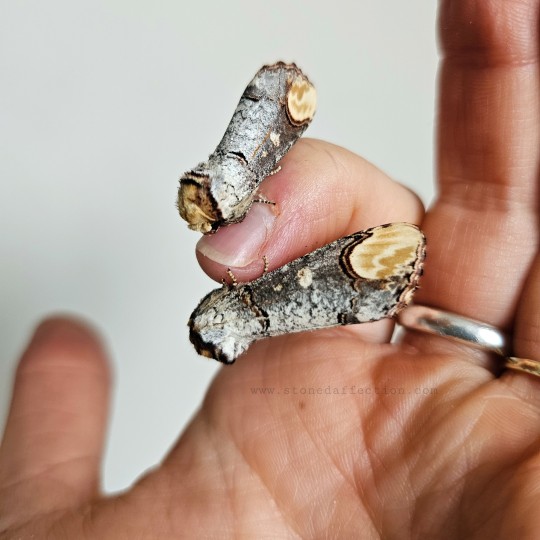#phalerae
Text
Moth of the Week
Buff-Tip
Phalera bucephala
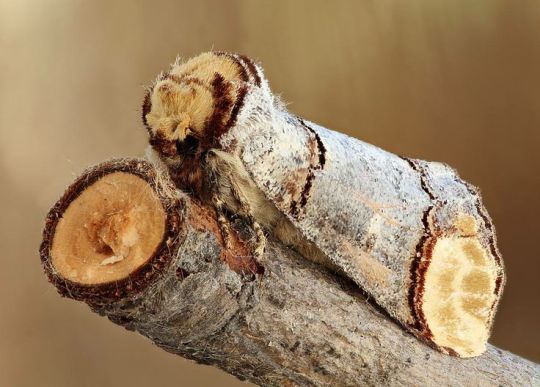
The buff-tip is part of the family Notodontidae and was first described in 1758 by Carl Linnaeus. They are best know for their resemblance of a broken birch twig when at rest. The name buff-tip comes from the color on the head and edge of the wings, buff: “a light brownish yellow, ochreous colour, typical of buff leather.”
Description The body is hairy, with a buff colored patch on the head followed by a brown ring. The upper body visible from under the wings is a mottled gray to match the forewings. The rest of the body is covered when resting and is a cream white with gray, cream and or brown legs. The forewings are also mottled gray with brown patterning and a buff patch at the tip mirrored on both sides. The hindwings are the same cream as the lower body. The antennae are brown and hidden when camouflaged.
Average wingspan: 55-68 mm
Males are smaller than females
Diet and Habitat Common food plants for this moth include the Norway maple, birch, chestnut, hazel, oak and many more. Caterpillars are social as young larva and eat in groups which can cause the defoliation of their host plants. Adult moths do not feed.
This moth is found across Europe and in Asia to eastern Siberia. It is very common in the British Isles, more so in the south than in the north. They prefer habitats with deciduous trees like open woodlands, scrubs, hedgerows, and urban gardens.
Mating Generally, the buff-tip can be seen from May to July, which is most likely their mating season. This moth is strictly nocturnal so it is also most likely they mate during the night. They have one generation per year with the females laying the eggs in clusters on the underside of leaves. The young larva are sociable and grow to be solitary through 4 instars.
Predators In order to protect itself while resting during the day, this species has adapted to look like a broken birch twig. This deceives common day time predators of moths such as birds and lizards.
Fun Fact This moth has been considered a pest in Lithuania for eating apple trees in the 1900s. High levels of environmental nitrogen compounds can increase outbreaks of the buff-tip.
(Source: Wikipedia, Wildlife Insight, London Wildlife Trust, Butterfly Conservation)
#libraryofmoths#animals#bugs#facts#insects#moth#mothoftheweek#lepidoptera#Notodontidae#buff-tip#Phalera bucephala
195 notes
·
View notes
Photo

121 notes
·
View notes
Text
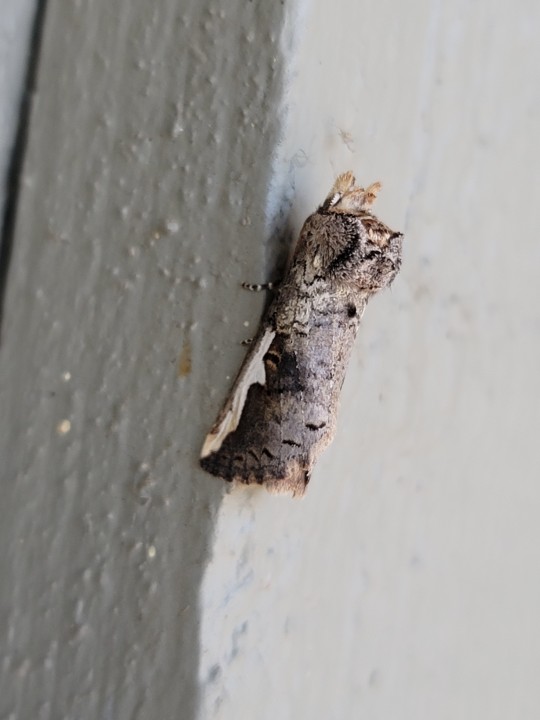

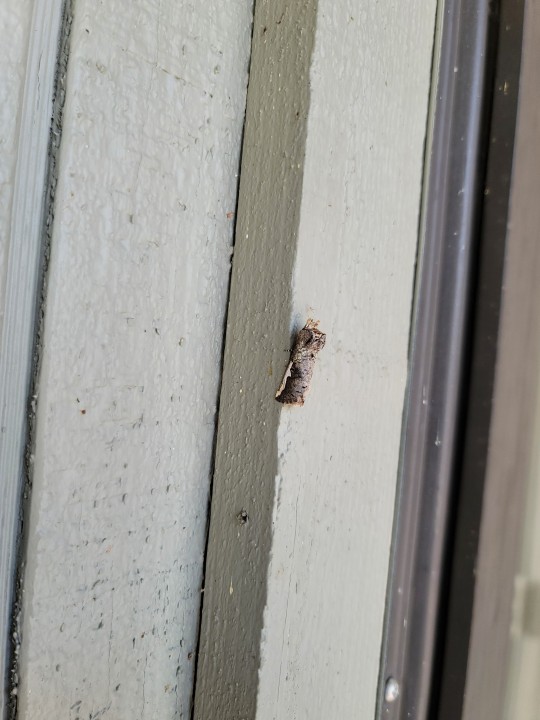
a beautiful moth at our door!!!
2 notes
·
View notes
Photo
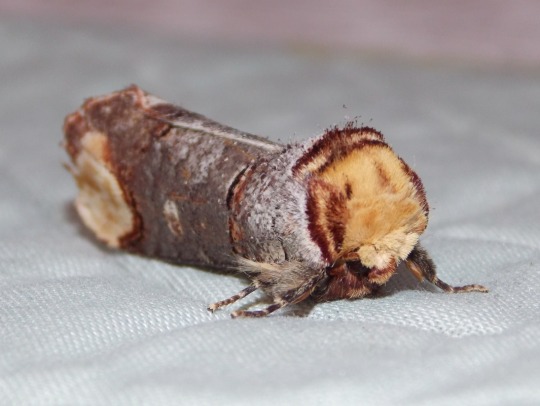
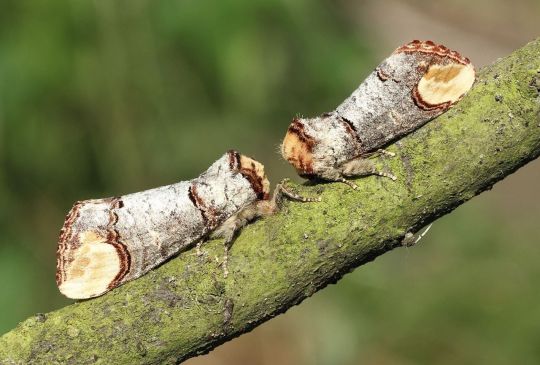

Buff Tip Moth Phalera bucephala
4 notes
·
View notes
Text
The Buff-Tip Moth: the resting posture, shape, and color/pattern of the buff-tip moth allows it to mimic a broken birch twig; the moth's buff-colored head and the patches on its hindwings even resemble freshly-snapped wood

It also definitely tends to look like there's a weird little smiley face in the setae surrounding the moth's head, which is arguably even more striking but for some reason none of the sources I dug up on this species seem to mention that weirdness.

This type of camouflage is generally referred to as a "protective resemblance" -- a form of mimesis in which an animal can avoid being preyed upon by mimicking an inedible/unremarkable aspect of its environment. Many different moths are able to disguise themselves in similar ways, and it is especially common within the family known as Lasiocampidae. Some of the other species that engage in protective resemblance include Gastropacha quercifolia, Gastropacha pardale, Gastropacha populifoli, Euthrix potatori, Euthrix laeta, and Calyptra minuticornis (along with the other members of genus Calyptra). Most of these moths disguise themselves as leaves/foliage.
The buff-tip moth is particularly adept at disguising itself, however, and the fact that it so strongly resembles such a specific object (i.e. not just a dead leaf or a vague piece of foliage -- but a broken twig from a silver birch tree, in particular) makes this disguise seem even more impressive/unique.
This species (Phalera bucephala) can be found throughout the British Isles, mainland Europe, and Asia, with its range extending into Eastern Siberia.

Sources & More Info:
Wildlife Insights: Buff-Tip Moth Identification Guide
ButterflyConservation.org: Buff-Tip Moth
The Wildlife Trusts: Buff-Tip Moth
Wildlife Insight: the Buff-Tip Moth
Moth Identification: P. busephala
Encyclopedia of Life: Global Map of Known Occurrences for P. busephala
Insecta: Phalera bucephala
Lepidoptera and their Ecology: P. busephaloides and P. busephala
Journal of Ecology & Evolution: Strong Foraging Preferences for Ribes alpinum in the Polyphagous Caterpillars of Buff-Tip Moth Phalera bucephala
Dickinson County Conservation Board: Protective Resemblance & other Forms of Mimesis/Mimicry
#lepidoptera#entomology#insects#bugs#buff tip moth#weird bugs#critters#animals#moths#are#wildly#underrated
23K notes
·
View notes
Text
Aziraphale
What's in a name?

Azir: Chosen one
Azira: "a rising star"; someone who will be successful

Pronounced as: "A zir, a phale"
Zir: Pronoun for a non-binary person
Phale: from the Middle English 'whal'/'hwal'/'wale'/'whale', used to denote any large, sea-dwelling mammal, such as walruses, porpoises, and whales.

Also: Phale: the sum of money or allotment of produce to be given to a landowner as rent

Phale: (spelled the same but pronounced "pah-lay") Tibetan word for bread.

Phale, frequently confused with Phiale:
Phiale: a shallow, ceramic or metal bowl, used for libations

Also: Phiale: a fountain in the entrance or front of a church, for blessing of water

Phale, from Phalera...
Phalera: A metal disc or medallion, usually worn on the breast as an ornament and as part of a military uniform

Also: Phalera: a genus of moth-- insects which are drawn towards light. Humans are ants; angels are bees; demons are hornets; flies are Lord Beezlebub's department...
Also: Phalera: a decoration for the harness of a horse, popular in ancient Rome
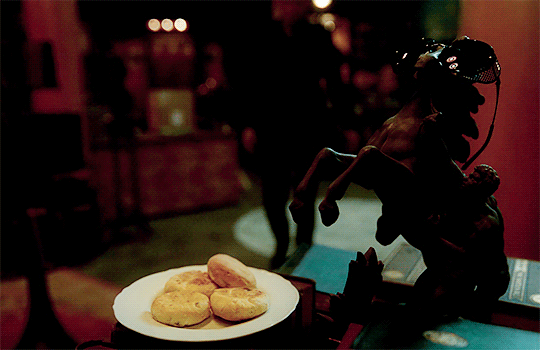
158 notes
·
View notes
Text

Ajax and Lysander
Inspired by this scene from Dark Age:
“Is it him?” Kalindora asks a taller, younger knight in armor the color of a storm cloud. His skin is black, his eyes violent amber. The pelt of a pearl leopard sways from his powerful shoulders as he steps forward to examine me. For a moment, it feels as if we’re both looking through a dirty pane of glass, leaning and squinting to see if the apparition on the other side is really a long-lost friend or merely some trick.
I barely recognize the man I once called “brother.”
Only the long lashes of his eyes are the same.
In the eleven years since I last saw him, his plump features, often an item of hushed ridicule on the Palatine, have melted away to reveal an Adonic visage so surly, so passionate, so manly even Cassius might, in a drunken moment, declare some minor flaw in the man in hopes of diluting his own utter jealousy.
Octavia was always disappointed in her little genetic experiment. She would not be now. Ajax, son of the loveless genetic union of Aja and Atlas au Raa, is a masculine specimen.
By the phalera that bedeck Ajax’s armor, I see he has already fulfilled his childhood dreams. He wears not just his Peerless scar, but insignia signifying the office of Storm Knight, and the rank of a full Legate infantry commander.
With my scarless face and my drab civilian vestments, before the two Olympic Knights, I feel my ten-year absence more acutely than ever.
“You are the man who claims to be Lysander au Lune,” Ajax sneers.
“Ajax.” Mistaking his tone for banter, I reach to embrace him. The Stained block my path. I actually feel wounded. “Don’t you recognize me?”
Ajax’s eyes narrow to slits. “Test him with the Manteío.”
Hope you guys like it!! ♥️
#red rising#red rising fanart#iron gold#pierce brown#Ajax au Grimmus#Lysander au line#dark age#howlers#sons of ares#myart
61 notes
·
View notes
Text
Clanmew Expansion Pack: Moths and Butterflies
A guide to the beautiful fluttering insects seen in this region, and how Clan cats classify and describe them.

[ID: A cat with a butterfly on its nose]
In Clanmew, the vocabulary used to describe butterflies is massive compared to English. As a species less than a foot tall and spending their entire lives in the wilderness, Clan cats observe lepidopterians up close and far more personally than humans have done historically.
Combine this with the fact that cats are crepuscular, active in the morning and evening, and you'll realize that they encounter more moths than butterflies. While English-speaking humans tend to think of moths as being dingy and butterflies as being colorful, Clan cats don't find those categories helpful and classify them in a completely different way!
So the very first thing to know is that Clanmew does not have the same conception of "moths" and "butterflies." They have a super term, "Ffyy," and no less than 9 terms for the various groups with related behaviors.
This guide contains 51 new words for various moths and the unique behaviors of lepidopterians. Below the cut, you will find;
An overview to the 9 classifications Clan cats use, plus words for things like cocoons, metamorphosis, caterpillars, etc
A straightforward list of species, in English (Science) = Clanmew format
Expansion on behaviors of noteworthy species within their groupings
Translation trivia on Moth Flight, Mothwing, Archeye, and Mothwhisker (TC) for Better Bones.
(Translator's Note: I have tried to pick English words that will work nicely as warrior name prefixes, to be translated as specifically or as generically as you desire. They don't reflect cladistic accuracy.)

Types of Ffyy:
Flutter = Kffa
Ffyy with large hindwings that flutter around erratically. The closest to the English image of a "butterfly." Most of these are daytime species but this also refers to moths that are drawn to flame.
Species depicted: Speckled wood (Pararge aegeria)
Hawkmoth = Uff
Fat-bodied ffyy that tend to be wider than they are long, with powerful wings. Fantastic fliers and important pollinators, they have several gigantic species and are beloved by Clan cats.
Species depicted: Elephant hawkmoth (Deilephila elpenor)
Tortrix = Owyy
Round-winged ffyy that rest with a slightly splayed pose with their wings folded down, almost resembling a turtle.
Species depicted: Privet tortrix (Clepsis consimilana)
Veneer = Iff
A thin, lanky ffyy that rests in a sticklike pose with a defined head, sporting big, buggy eyes and sometimes a large nose. Any moth with the characteristic eyes or nose gets brought back into this category.
Species depicted: Garden-grass veneer (Chrysoteuchia culmella)
Herald = Hawof
A very unique type, it can apply to just about any type of moth but is always given to the species with significance in prophetic divination. There are some moths rarely seen in this region which appear only as heralds, thus they are named accordingly.
NOTE: This is the sort of word bestowed in Honor Titles.
Species depicted: Common Hairstreak, Moth Flight's moth (Callophrys rubi)
Dowd = Gyyff
Stiff, fluffy moths which rest as straight as a twig, usually mimicking wood. Their heads aren't as well defined as a veneer, but they aren't as fluffy as a raoff
Species depicted: Buff-tip (Phalera bucephala)
Prominent = Raoff
"Lion moths," large species with fluffy antennae and big manes. Something between a dowd and a tortrix, but usually larger and fluffier.
Species depicted: Muslin moth (Diaphora mendica)
Plume = Ffip
Very thin, slender moths that rest in a T-pose with very interesting wing-types.
Species depicted: Beautiful plume moth (Amblyptilia acanthadactyla)
Fritilary = Ffow
Somewhat between a Kffa and an Owyy, refers to Ffyy with a smoother 'cape' shape when they're resting.
In addition, there are words for shapes associated with Ffyy and other insects, especially in the wings and patterns. Some of those words are;
Fluttered/Fluttering/Will flutter = Afafaf/Afafa/Afaf
The erratic wingbeats of Ffyy and small birds of prey.
Hovered/hovering/will hover = Hyyffuhu/hyyffu/hyyff
A very special aerial maneuver where an animal can hold their exact place in the air and move in any direction. EXTREMELY rare; only achieved by certain hawkmoths, hoverflies, and dragonflies.
NOTE: The UK has no hummingbirds! Their ecological niche is occupied by hawkmoths!
Shy = Wro
An emotion, but also a pose. It's when an animal shrinks back and tries to make itself smaller or more hidden, much like a Dowd or a Veneer, or the flattening of a terrified cat's ears
Cape/Humble = Froom
An emotion, a shape, and a pattern that is seen on the backs of some animals, describes the way that Prominents and Tortrixes hold their wings.
Flare/Confident/Perpendicular = Akeye
An emotion and a shape, describes things that 'stick up,' like the wings of Plumes and Butters. Not like "raised hackles," more like fluffing one's fur out or puffing your chest.
Caterpillar = Poog
A word that comes from Parkmew! Caterpillars were significant to Park cat culture because of their old naming system-- cats were born unnamed, and were expected to find one as they grew, like butterflies.
Pupa/Chrysalis = Higab
Hard, scaly insect cocoons
Cocoon = Mooun
Soft, silky insect cocoons
Silk = Mirro
The material that silk cocoons and spider webs are made of. Only cob spiders produce though of this material to be useful to Clan cats; they do not have access to silk moths (bombyx mori) in this part of England. Clan cats also believe that moth wings are made of this.
Chitin = Higko
The material that hard pupa and insect exoskeletons are made of.
Exoskeleton = Babaak
The hard shell that surrounds the meat of invertebrates such as crabs, moths, beetles; Clan cats do not think this applies to insects that 'shrivel' such as soft-bodied caterpillars.
Metamorphosed/metamorphing/will metamorph = Peb'bep'arr/Peb'bep/Peb'be
To massively change between stages of life, the unique way that moths and some other insects grow.
LIST OF SPECIES
This list is arranged with several species of each group, separated by grouping. You can expect for this list to grow, if additional species are translated as time goes on!
Last update: 6/17/2023
HAWMOTH/UFF
Elephant hawkmoth (Deilephila elpenor) = Beksu
Large skipper (Ochlodes sylvanus) = Skepb
Hummingbird hawkmoth (Macroglossum stellatarum) = Lipfu
TORTRIX/OWYY
Privet tortrix (Clepsis consimilana) = Frooke
Oak lantern (Carcina quercana) = Byoff
Common footman (Eilema lurideola) = Yyowo
Dark Arches (Apamea monoglypha) = Oyiw
VENEER/IFF
Garden-grass veneer (Chrysoteuchia culmella) = Chuo
Drinker moth (Euthrix potatoria) = Ssbwohl
Bronze alder moth (Argyresthia goedartella) = Holipo
DOWD/GYYFF
Buff-tip (Argyresthia goedartella) = Kooko
Apple leafminer (Lyonetia clerkella) = Rugna
Hazel slender (Parornix devoniella) = Geehees
PROMINENT/RAOFF
Muslin (Diaphora mendica) = Goorf
Iron prominent (Notodonta dromedarius) = Orge
True lover's knot (Lycophotia porphyrea) = Urmrri
Cinnabar (Tyria jacobaeae) = Genra
PLUME/FFIP
Beautiful plume (Amblyptilia acanthadactyla) = Lebl
Twenty plume (Alucita hexadactyla) = Arrffip
FLUTTER/KFFA
Speckled wood (Pararge aegeria) = Yaero
Holly blue (Celastrina argiolus) = Luya
Clouded border (Lomaspilis marginata) = Oogwo
FRITILARY/FFOW
Magpie moth (Abraxas grossulariata) = Peewo
Mint moth (Pyrausta aurata) = Mwifg
Riband wave (Idaea aversata) = Fisip
HERALD/HAWOF
Green Hairstreak (Callophrys rubi) = Ssefyy
Lunar Hornet (Sesia bembeciformis) = Offes
Death's Head (Acherontia atropos) = Wayoff
HAWKMOTH/UFF

[ID: An "Uff," 'Hawkmoth' in English. It is a large, yellow-and-pink moth. The species depicted is an Elephant Hawkmoth.]
Hawkmoths are the largest types of Ffyy that Clan cats encounter, and deeply beloved. They are considered the 'warriors' of moth-standards, large, honorable, and acrobatic. What defines an uff from other butterflies is primarily its large, bulky body. Some uff, such as the skipper, could be mistaken by outsiders as being a type of ffow or perhaps a kffa.
They are pollinators, jumping between various flowers and mostly seen in grassy, floral environments, such as meadows and moorland. The skipper in particular is one of WindClan's most common butterflies, and a favorite target for pouncing kittens.
Most of the largest hawkmoths survive the winter snug in their cocoons under leaf litter, and more specifically in ThunderClan. Being able to witness a hawkmoth emerge is sometimes taken as a little blessing, like StarClan rewarding you for staying observant on a patrol.
TORTRIX/OWYY

[ID: An Owyy, "Tortrix" in English. It is a humble brown moth with a negligible mane and round, capelike wings. The species depicted is a privet tortrix.]
Tortrixes are the largest classification of ffyy in Clanmew, with many of them being drawn to lights in the dark. They hold their wings 'humbly' (froom), tucked behind themselves and slightly angled. Many prominent share the general shape of tortrixes, but they are separated by a prominent, impressive mane.
Because they are so varied, classifying behaviors of the group as a whole is difficult. Some of them like fruit and others like leaves. Some are large and others small. Some are drab and others colorful.
Most end up named after the species of plant they like most. The Oak Lantern (Byoff) for example can skeletonize entire oak leaves! Others can absolutely mob apple trees, making them a pest to ThunderClan.
Funfact: The cartoon idea of an "apple worm" comes from some species of tortrix moths!
FLUTTER/KFFA
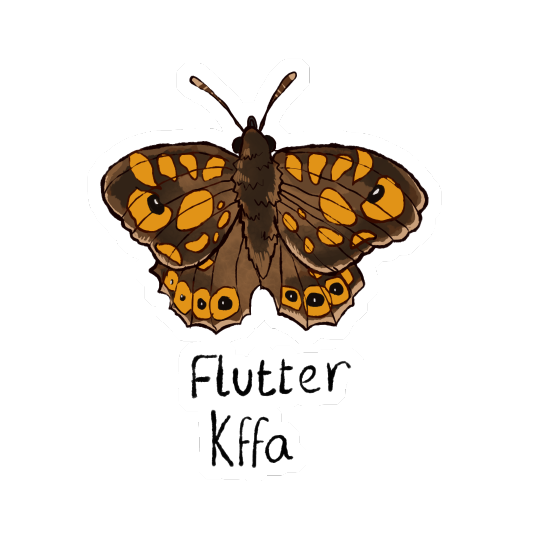
[ID: A Kffa, "Flutter" in English. It is an orange-and-brown butterfly, with wings that stick out perpendicular to the body. The species depicted is a sunspot butterfly.]
Dominated by strange daytime species with bright colors, these confident little creatures are defined by the angle of their wings when resting. They "Flare" out, or Akeye in Clanmew.
The Yaero (sunspot butterfly/speckled wood) is the most well-known of the flutters which isn't also a herald of some sort. These plucky bugs have short lives and spend the ENTIRE time fighting, choosing a sunny spot and engaging in clumsy aerial brawls to defend it. To be compared to a Yaero in Clan Culture is like being called 'scrappy,' fighting until you drop dead of exhaustion.
It's a VERY admirable thing to be!
PROMINENT/RAOFF

[ID: A "Raoff," or a Prominent in English. It is a very fluffy moth with a big mane. The species depicted is a male muslin moth.]
The obvious thing that sets this sort of Ffyy apart from all others is its luscious, majestic mane. Much like how the "Leopard" is a mistranslation and is a mythical composite of several animals, the Clan cat "Lion" is a composite beast whose mane comes from moths!
Thus, it is how they were named. Lion + Moth.
And, of the various raoff, the muslin (Goorf) is one of the most interesting. It comes in black or white, with many cats speaking of a herald coloration that is split perfectly down the middle with black and white. This species' name comes from "Gender + Moth." It is thought that if a pregnant cat only sees black muslins, they will have an all-tom litter. All white, and they will all be mollies. If no muslin moths are seen at all, then they will all reveal themselves to be gib.
FRITILARY/FFOW
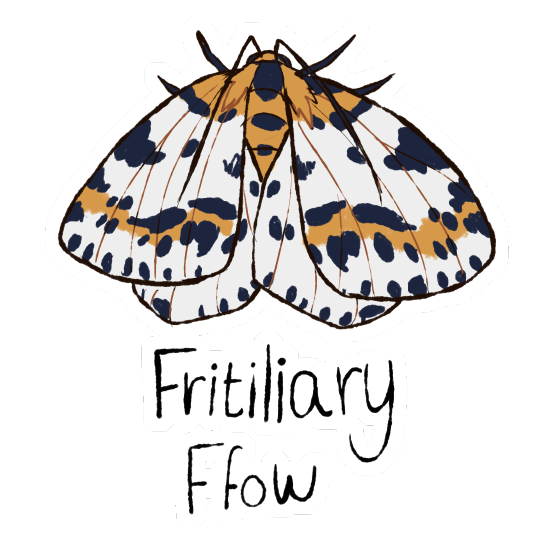
[ID: A "ffow," or a fritilary in English. Note, this is the moment where the English names diverge the most because this is not an irl fritilary. It is a moth with a 'cape' that is both froom, and akeye. The species depicted is a magpie moth.]
A family of ffyy remarked upon for their 'savviness.' Not as 'confident' as kffa, nor as humble as an owyy, the animals in this family are typically quite interesting.
For example, the magpie (Peewo). While notably beautiful like a calico cat, it's also strangely left alone by other animals. If caught in a spiderweb, the spider will take a bite and let go. Birds leave them alone. Clan cats believe this must be because they will eat lots of unappetizing plants and become distasteful-- a clever creature!
The thought probably came from watching another ffow, the Mwifg, the "mint moth" in English. Mint is a deadly poison to Clan cats, but the creature eats it up, and goes unbothered by other animals.
So, Peewo and Mwifg are cited often as living examples of how you, "are what you eat."
PLUME/FFIP
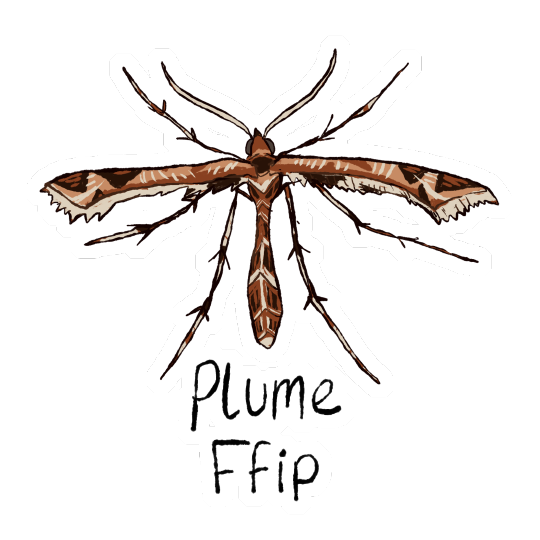
[ID: A plume moth, "ffip," a thin insect with a T-shaped body and long legs. The species depicted is a Beautiful Plume Moth.]
Widely considered the least appealing type of moth, often clustered in reedy areas. They're known by their distinctive T-shape and long legs.
Clan Cats find it unsettling that they resemble midges, and have only two unique names within the classification; Arrffip for the 20-Plume, and Lebl for the Beautiful Plume, which resembles a mottled cat which makes it more okay to them.
VENEER/IFF

[ID: A moth with big eyes and a long nose, called an "Iff" in Clanmew, and a veneer in English. The species depicted is a garden grass veneer.]
The silliest moth of all, associated with being panicked and anxious at all times. To be compared to an Iff is to be called a worry-wart in Clanmew!
Most veneers have a big, distinct fuzzy nose, and any moth that displays the same feature gets thrown into the Iff classification. But that isn't the only way to end up in this category! Any moth with big, worried eyes goes here as well, such as the Bronze Alder Moth (Holipo).
Alderheart was compared to a holipo often. Poor guy.
There is also the drinker moth (Ssbwohl), which is known for dunking its head into dewdrops and taking a big sippy.
DOWD/GYYFF

[ID: A moth that looks like a twig, called a Dowd in English and a Gyyff in Clanmew. The species depicted is a buff-tip.]
To be considered a Gyyff, the moth must be long and sticklike. The apple leafminer (Rugna) is a good example of a moth that is not using buff-tip (Kooko) mimicry, but is still a Dowd in Clanmew standards.
The word "kooko" in Clanmew is used for harmless fibs, little pranks, and the buff-tip moth!
HERALD/HAWOF
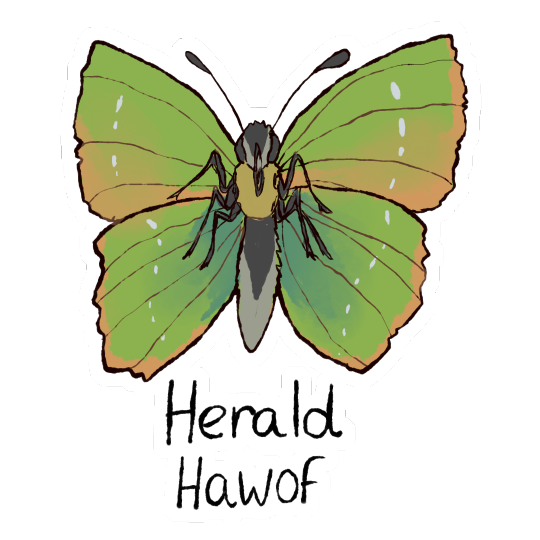
[ID: A green butterfly with shining wings, facing the camera. It is called a Herald in English, and a Hawof in Clanmew. The species depicted is a Green Hairstreak.]
The defining example of the Herald classification is the Green Hairstreak, an iridescent green moth that lead Moth Flight to the Moonstone so many years ago. A vitally important species to WindClan culturally, a burst in its population is said to be a sign that they need to listen carefully.
Any type of moth can end up going into this category, if it becomes significant in divination. Some moths have even shifted over time out of one classification into Hawof, and back out as they stop being seen as holy in some way!
Another example of a moth of great significance is the death's head moth, called a Wayoff in Clanmew. It's a massive type of hawkmoth, and an exceedingly rare sight. It warns of grand doom, threats so large that they threaten all the Clans at once. Floods, famine, deforestation... these were all preceded by the freak sighting of a Wayoff.
Meanwhile, the Lunar Hornet, Offes in Clanmew, mimics a wasp perfectly. It's a strange creature said to be a piece of the cosmic dust between this world and StarClan, an example of the fantastic creatures they can make if they so choose. It signifies change of some sort, which a Cleric will attempt to interpret for the cat who saw the moth.
And lastly,
Translation Trivia

[ID: A cat chasing a butterfly]
Specifically for the way I have chosen to translate the names of these characters for the Better Bones AU
Moth Flight
Mothwing
Archeye
Mothwhisker
Moth Flight
Hawof Faofwe
(Herald + Pilgrimage)
A VERY interesting translation quirk, as her name is a remnant from Old Tribemew, one of the ancestral languages that would eventually form Clanmew!
Hawof was the ancient word for moths and butterflies, and still the word in-use in Tribemew to this day. Once they moved down from the highlands, Clanmew adopted and created several new words to describe the hundreds of new types they were seeing on a regular basis. Yet, "hawof" fossilized, coming to only describe those that were particularly holy!
"Faofwe" is another fascinating example. While it once meant 'flight' in Old Tribemew, an animal flying from one place to another, it has come to mean "pilgrimage." This is the word being used for a cat going to visit a holy location, or somewhere else that they will reach a higher religious understanding of the world.
Both of these words are sacred; the type only given to modern cats in Honor Titles.
Mothwing
Beksuwesk
(Elephant Hawkmoth + Insect Wing)
Sasha fled the violence of TigerClan at her first opportunity, after being trapped in the dangerous situation with no escape. After the death of her son, Tadpole, she brought her kits to RiverClan in the hopes they would be safe. Their names were Ffyy, and Yassga.
Leopardstar saw that their father was Tigerstar, and accepted... though she would change their names. They had to accept what the Clan was to decide for them.
So Yassga (Raptor, any large bird of prey) became Yi'i (sparrowhawk), and Ffyy (Any butterfly) was pigeonholed into a type of hawkmoth as Besku. She thinks of this often, that RiverClan took the name her mother gave her, that she followed Hawkfrost to the Lake, and now she is all that remains. With nothing left of her family.
Archeye
Oyiwipo
(Dark Arches Moth + Eye)
A simple one! He has a stripe just above one eye that perfectly resembles the tip of a Dark Arches' wing.
(note: i updated this translation from an earlier statement.)
Mothwhisker
Yaerohussk
(Speckled Wood Butterfly + Hussk)
Fresh from the ThunderClan Family Tree fix, Mothwhisker is a parent of Adderfang and Seedfall.
An old Oakstar loyalist, Mothwhisker was spitting from the moment he was born, clawing the nose of his Ba. On the spot, he was given the prefix Yaero, and he eventually grew into a ferocious Crusader after the death of Mapleshade's kittens and the creation of Darkstar's Commandment.
Though "Butterflywhisker" would technically have been accurate, the translator chose 'moth' for brevity. Clan cats don't distinguish between the two, regardless.
#I HOPE YOU ALL UNDERSTAND#THIS IS THE RESULT OF ME SORTING THROUGH HUNDREDS OF INSECTS#AND COMING UP WITH A UNIQUE SYSTEM OF CLASSIFICATION#IM SCREECHING#clanmew#buttterflies#moths#insects#lepidoptera#clan culture#fauna guide#better bones au
161 notes
·
View notes
Text
Moth Of The Day #30
Buff-tip Moth
Phalera bucephalia
From the notodontidae family. They have a wingspan of 44-68mm. They tend to inhabit open woodland, scrub, hedgerows and gardens. It is found throughout Europe and in Asia to eastern Siberia. It resembles a broken twig, which allows it to camouflage itself and avoid predators.
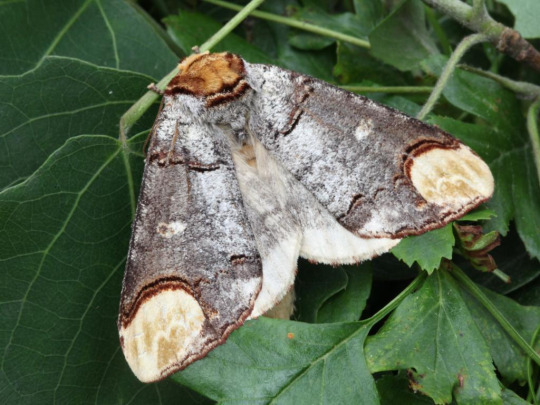

#moth#moths#motd#moth of the day#pretty moth#insect#bug#nature#buff tip moth#notodontidae#lepidopterology#lepidoptera
165 notes
·
View notes
Text
Animal of the Day!
Buff-Tip Moth (Phalera bucephala)
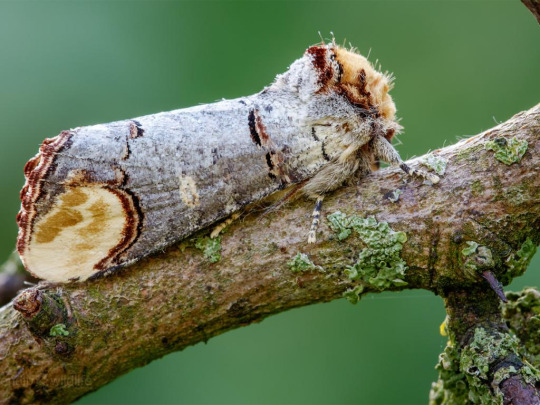
(Photo from Butterfly Conservation)
Conservation Status- Unlisted
Habitat- Europe; Asia
Size (Weight/Length)- 3.5 cm
Diet- Tree sap; Leaves
Cool Facts- While maybe not as pretty as a butterfly, that’s not really the buff-tip moth’s style. Being a relatively large moth, these friends needed to find a way to escape the eyes of predators. Their wings have a patterning that perfectly mimics a twig and their fur looks like a broken bit. Unlike other moths, buff-tip moths aren’t attracted to light. While the adults don’t eat and survive off of fat stores until they mate. Caterpillars gorge themselves on tree leaves. Apple leaves are a favorite, sometimes causing these moths to be considered pests.
Rating- 11/10 (No need for flashy colors.)
#Animal of the day#Animals#Insects#Moths#Sunday#February 5#Buff-tip moth#biology#science#conservation#the more you know#cw: insects
211 notes
·
View notes
Text
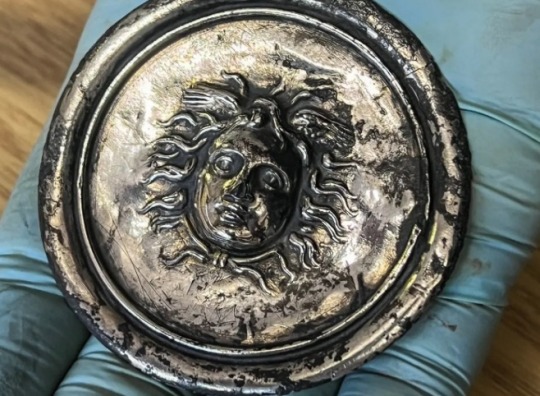
Silver Medusa Medal Found at Vindolanda
The snake-covered head of Medusa was found on a silver military decoration at a Roman auxiliary fort in England.
A nearly 1,800-year-old silver military medal featuring the snake-covered head of Medusa has been unearthed in what was once the northern edge of the Roman Empire.
Excavators discovered the winged gorgon on June 6 at the English archaeological site of Vindolanda, a Roman auxiliary fort that was built in the late first century, a few decades before Hadrian's Wall was constructed in A.D. 122 to defend the empire against the Picts and the Scots.
The "special find" is a "silver phalera (military decoration) depicting the head of Medusa," according to a Facebook post from The Vindolanda Trust, the organization leading the excavations. "The phalera was uncovered from a barrack floor, dating to the Hadrianic period of occupation."

Medusa — who is known for having snakes for hair and the ability to turn people into stone with a mere glance — is mentioned in multiple Greek myths. In the most famous story, the Greek hero Perseus beheads Medusa as she sleeps, pulling off the feat by using Athena's polished shield to indirectly look at the mortal gorgon so that he wouldn't be petrified, according to the Metropolitan Museum of Art in New York City.
Roman culture drew on Greek myths, including Medusa's story. During the Roman age, Medusa was seen as apotropaic, meaning her likeness was thought to repel evil, John Pollini, a professor of art history who specializes in Greek and Roman art and archaeology at the University of Southern California, told Live Science. Pollini was not involved in the find at Vindolanda.

"From Greek times on, this is a potent apotropaic to ward off bad things, to keep bad things from happening to you," Pollini said. Medusa's serpent-surrounded head is also seen on Roman-era tombs, mosaics in posh villas and battle armor. For instance, in the famous first-century mosaic of Alexander the Great from Pompeii, Alexander is depicted with the face of Medusa on his breastplate, Pollini noted.
Medusa is also featured on other Roman-era phalerae, but the details vary. For instance, the Vindolanda Medusa has wings on her head. "Sometimes you see her with wings, sometimes without," Pollini said. "It probably indicates she has the ability to fly, sort of like [the Roman god] Mercury has little wings on his helmet."

Because phalerae were awarded for "valor in battle," military men would attach them to straps and wear them during local parades, Pollini said, noting that the discovery of the Vindolanda phalera is rare.
"There aren't very many of them, obviously, because they were a precious metal," he said. "Eventually, most of them were probably melted down."
Many phalerae are found in burials, but the Vindolanda one appears to be lost. "This isn't something you would toss away," Pollini said.
The silver artifact is now undergoing conservation at the Vindolanda lab. It will form part of the 2024 exhibition of finds from the site.
By Laura Geggel.

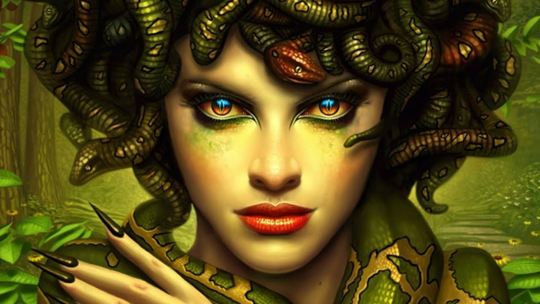
#Silver Medusa Medal Found at Vindolanda#Hadrian's Wall#silver#silver medal#ancient artifacts#archeology#archeolgst#history#history news#ancient history#ancient culture#ancient civilizations#roman history#roman empire#roman art#roman legion
64 notes
·
View notes
Note
what's your favorite species of:
spider
wasp
butterfly
moth
beetle
(bonus points if u include pics for each one)
AHHH AHH AHH OK OK!! This ask actually made me so excited I couldn’t even think about responding for a few moments cause I was stimming so hard. Oh my god. Ok. Wow this is a tough question.
Starting with spiders!!! Ok I KNOW there’s a lot of super cool/crazy/smart/venomous/absolutely buckwild species out there but my favorite is purely sentimental. It’s Tigrosa Georgicola. I see them everywhere where I live and they’re one of the first species I ever picked up. My phone screen is literally a photo of me holding one.
I’ve got a soft spot for wolf spiders anyways cause they purr and carry their babies on their backs and are just so gorgeous and big and amazing but this one especially is so good. One of the most docile species of spider I’ve handled, and their orange banding against their dark brown bodies is just so gorgeous. They’re literally tortoiseshell, what more could you want? And they get SO BIG it’s always such a delight finding one of these guys I love them so much
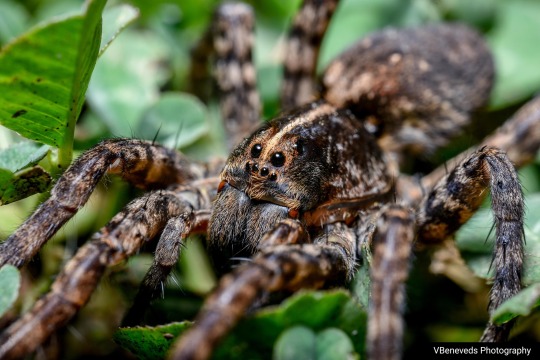
Next up wasp. Oh man big question. Lots and lots of good options and I am SO fond of paper wasps and mud daubers but I think if I had to pick a favorite it would be Auplopus carbonarius. They’re an absolutely TINY species of spider wasp that I’ve only had the pleasure of meeting once. Adults only get about 3/8” long. They also make little barrels to store food in!! And are great recyclers with their nests, they often take over old beetle burrows!! That’s so cool they’re like little home renovators. Here’s a pic of me holding one

Alright onto butterfly. This one’s a little harder since I’m not super into butterflies, but man there’s still definitely some really cool ones.
My favorite has gotta be Hamadryas feronia, aka the variable cracker. That entire genus is fucking gorgeous though, so shout out to some of the other species like the red cracker, ringless blue cracker, grey cracker, and the velutina cracker. Seriously just look up cracker butterflies. They’re all gorgeous. They also make a really cool cracking noise!! Look it up!!
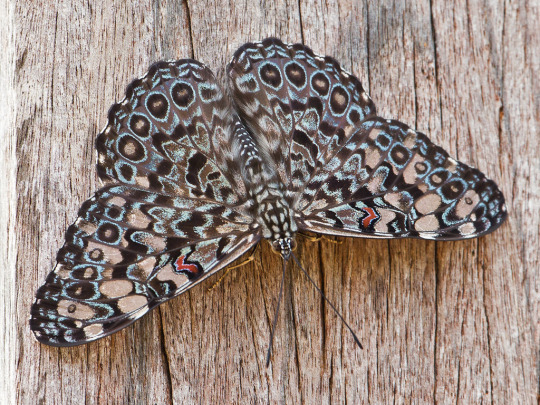
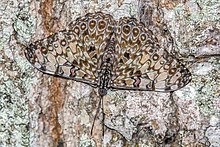

Ok ok next! favorite moth. This is a REAL close toss-up between clearwing hummingbird moths and buff-tip moths. Vampire moths were also high up on the list, but I think buff-tip moths have to win. Phalera bucephala to be more specific. They’re just so delightful. Their camouflage is SO GOOD they really do look like such perfect little broken pieces of branch. It’s endlessly endearing. AND their caterpillars are such a pretty yellow color. Everything about these guys just makes me smile


Next is beetle!!! Ok I’m a basic bitch on this one sorry, but trilobite beetles have won my heart. I don’t have a specific favorite species within the genus, they’re all just amazing. It’s also really funny to me how big the difference is between males and females. The females retain their larval form as adults, which is already cool enough for any species, but it’s especially wild seeing how these guys’ larval form looks. There’s nothing about these guys that isn’t amazing to me

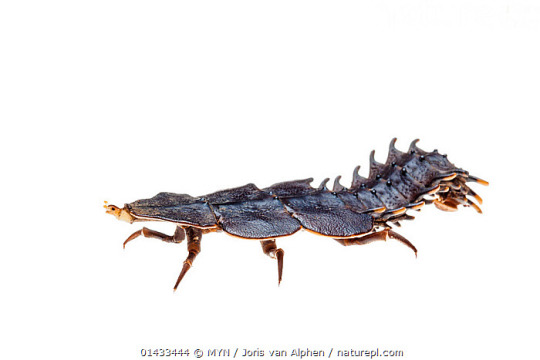

#beetles#spiders#moths#butterflies#wasps#bugs#THNK YOU FOR THIS ASK#There’s so many cool species I need to talk about#you wanna ask me about my favorite craneflies sooooo bad#seriously these guys are all so lovely tysm for giving me an excuse to show off some cool bugs
32 notes
·
View notes
Text
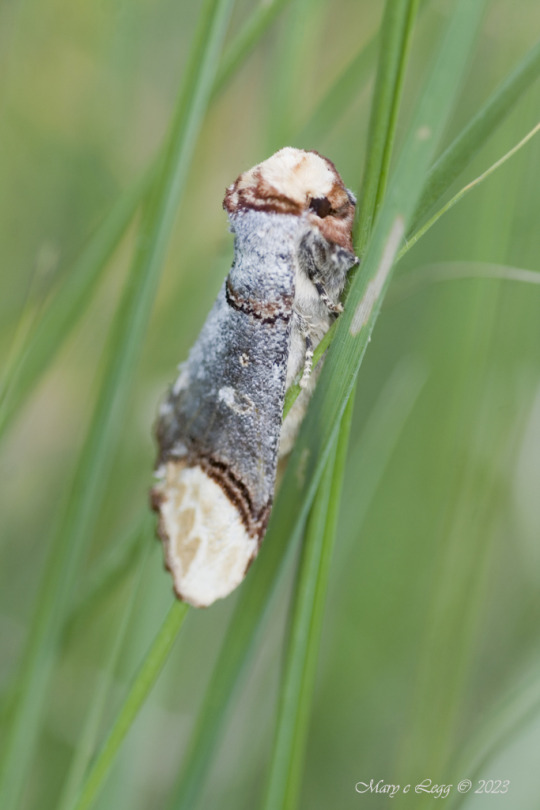
Buff Tip, Phalera bucephala Canon 400D EF 100 2.8 f/3.2 1/200 iso: 200 Milovice, Czech Republic 5/27/2012
#mothsMatter#moths#lepidoptera#Notodontidae#insects#invertebrates#macro#insectphotography#macrophotography#insect#canon#grasslands
6 notes
·
View notes
Photo
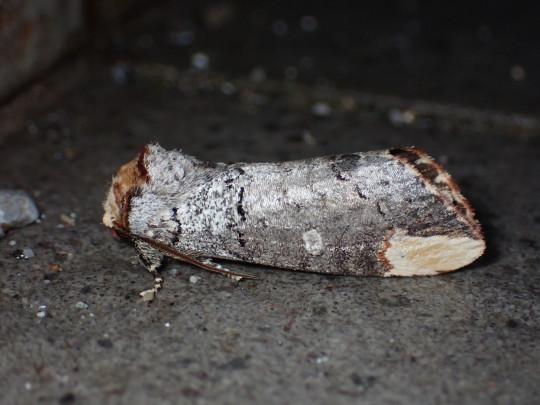
Phalera minor クロツマキシャチホコ
2021, Japan
27 notes
·
View notes
Text

Chenille de Bucéphale (Phalera bucephala), qu’une brise soudaine a fait choir de son arbre et atterrir sur Mireille qui n’en demandait pas tant
3 notes
·
View notes
